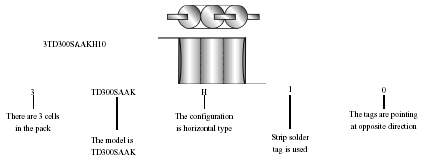¡@
| Battery
Description
1). Designation System The designation of a battery pack is compased of 5 code numbers each of them are used to identify different information:
The sequence of code follows the above information flow: An example of such designation method is shown below;
The coding system of configuration, tag type, tag direction; etc, are explained in the following section. ¡@ 1.1). Tag Direction
¡@ If connector is required, the code "C" is used. Below are some standard models of connector we can supply. (1) JST LR-02F-1 (2) JST EHR-2 (3) MOLEX 5264-02 (4) MITSUNI R14-62102 (5) UNIVERSIAL ¡@ 1.2). Standard Tag Type ¡@ ¡@ ¡@ If no tag is needed, code 3 can be used. If there are special requirements on the tags or wires, please inform ¡@ 1.3). Standard configuration for battery packs ¡@
¡@ A drawing of the configuration will always be welcomed. If the configuration falls out of the above standard once, a code X can be given to identify its uniqueness. |
¡@


















